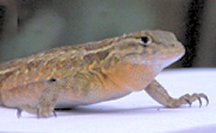Willing to stand between the neighborhood bully and your pal next door?

California lizards doing just that may have a genetic quirk that scientists have been looking for since the 1960s but hardly ever found.
The search for the genetic phenomenon began as theorists wondered why altruism doesn’t just self-sacrifice itself out of existence, explains Andrew G. McAdam of Michigan State University in East Lansing.
One explanation proposed a powerful gene that lets carriers recognize each other and pushes them to do favors for others of their species who happen to carry the gene. For example, men sporting green beards might do good deeds for other green-bearded men, even if they’re not brothers or even cousins.
Scientists have occasionally reported signs of what they began calling the greenbeard gene in fire ants and a few other species (SN: 8/8/98, p. 86). However, “there’s not been a lot of evidence for it,” says McAdam.
Now, he and his colleagues propose a new case: the true pals among side-blotched lizards.
The new results come from Barry Sinervo of the University of California, Santa Cruz. Males with blue throats tend to stake territories next to a blue pal. If one of the bigger, more aggressive males—often with orange markings—moves in, he harasses the nearest blue male relentlessly. Yet the blue harrassee stands his ground, even though he’d get more opportunities to mate if he abandoned the fight. His steadfastness keeps the bully away from the second blue lizard, which can then mate without interference.
Sinervo’s study shows that the pairs of blue-marked lizard neighbors typically aren’t close kin. Yet a genetic analysis shows three chromosome regions might contain an elusive greenbeard gene, the researchers propose in the May 9 Proceedings of the National Academy of Sciences.





